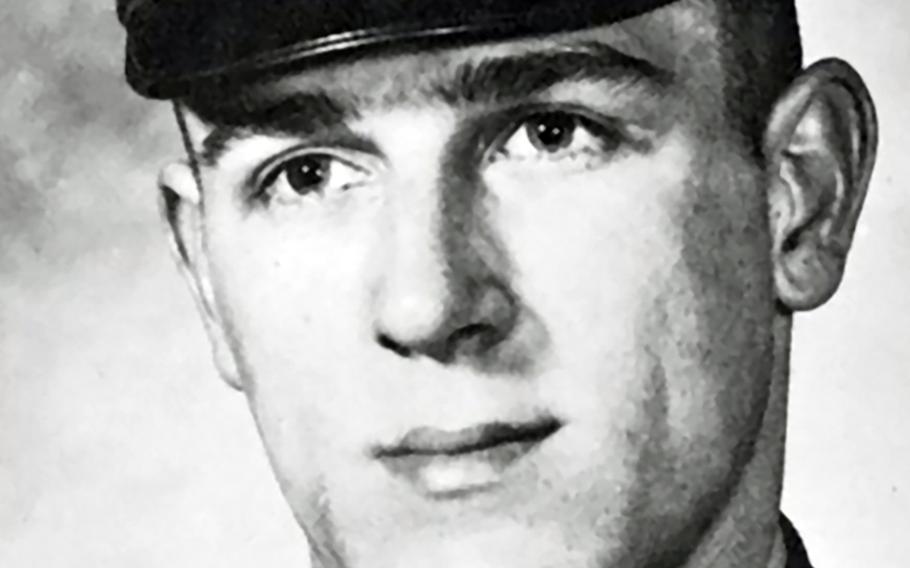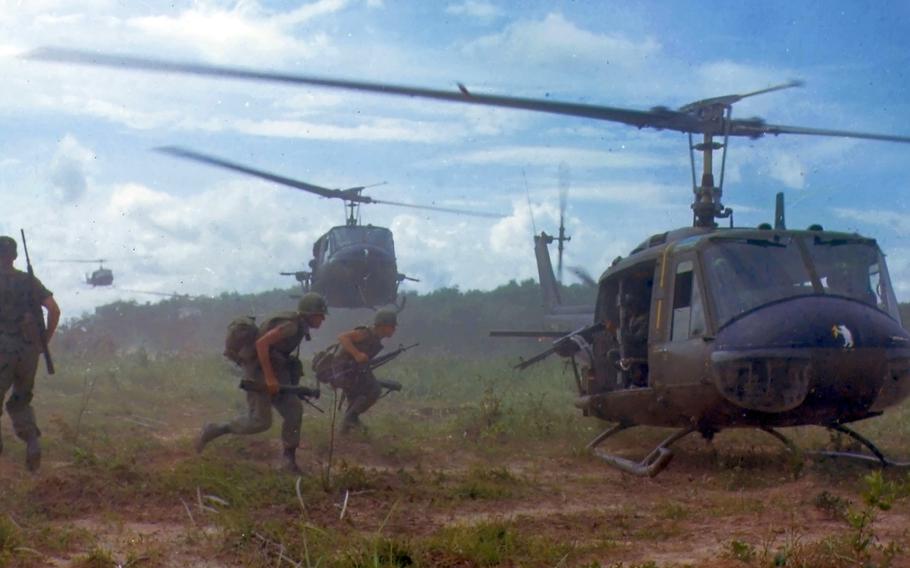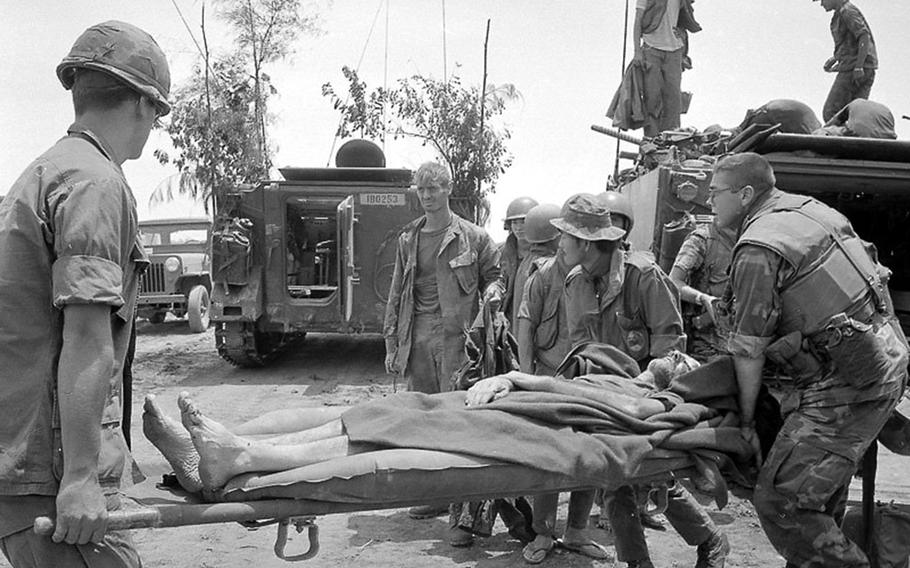
The remains of Army Chief Warrant Officer Larry Zich, who died in a helicopter crash in South Vietnam on April 3, 1972, were identified by the Defense POW/MIA Accounting Agency on Oct. 25, 2022. (DPAA)
Chief Warrant Officer Larry Zich turned 24 on the last day of his life.
On his birthday, April 3, 1972, he was copiloting a Huey helicopter that crashed somewhere in South Vietnam. Searchers were unable to find the crash site, and the remains of Zich and the other three crew members were never found.
Last month, the Defense POW/MIA Accounting Agency notified Zich’s next of kin that the young soldier had been accounted for using the sole remains in its possession for more than three decades: a single wisdom tooth.
The route by which that molar made it from a Vietnam jungle to a Defense Department lab in Hawaii remains a partial mystery. But the decades-long effort to determine to whom the tooth belonged is a story of evolving technological advances, a process of elimination and forensic hunches.
Zich’s last flight came in the first days of the Easter Offensive, a massive half-year attack by the North Vietnamese regular army, with troops crossing the demilitarized zone, or DMZ, into South Vietnam.
Zich, serving in the 37th Signal Battalion, 1st Signal Brigade, was tasked with flying from Danang to a base in Quang Tri province bordering the DMZ to deliver explosives to be used to destroy equipment before the area was overrun, said Chris Williamson, a Southeast Asia specialist with DPAA and lead analyst on the Zich crash.
Zich’s Huey never made it to that base.
“We know from communications from other helicopters flying that morning that Zich’s aircraft apparently got lost in the weather,” Williamson said by phone Nov. 22. “They were flying above the clouds, and they weren't able to see the terrain below them.”
The “best theory” for the cause of the crash is that the Huey was hit by either a surface-to-air missile or shoulder-launched missile, both of which the North Vietnamese army had deployed farther south than ever before, Williamson said.

U.S. Army UH-1D Huey helicopters, similar to the one copiloted by Larry Zich when he crashed in 1972, airlift soldiers during a search-and-destroy mission in South Vietnam in 1966. (U.S. Army)
Nine paper packets
The United States withdrew all combat troops from South Vietnam in spring 1973 with the signing of the Paris Peace Accords. In April 1975, Saigon fell to the North Vietnamese.
Refugees flowed out from Vietnam, as well as Cambodia and Laos, over the following dozen years.
The first stop for many were refugee camps in Southeast Asia, where American officials vetted those headed to the U.S.
The protocol was to debrief Vietnamese refugees about any information they might have on American combat losses, burials, crash sites, “anything that would help us for when we got back into Southeast Asia and started doing this work trying to find and recover our lost soldiers,” Williamson said.
In 1988, one of those refugees ended up at a camp in Malaysia, where he presented the debriefer with nine tiny paper packets, each containing a fragment of remains such as a tooth or bone chip.
The refugee told officials that he had gotten them from his uncle, who had told him some were from aircraft crash sites.
In April 1988, the remains were turned over to the Defense Intelligence Agency, which at the time was overseeing recovery and identification of missing service members from the Vietnam War. The remains ultimately ended up in the Defense Department’s forensic laboratory at what is now Joint Base Pearl Harbor-Hickam.
‘Peeling an onion’
It is quite possible the packets of remains the refugee possessed originated in an illicit remains trade that flourished in the two decades following the end of the war, driven by persistent rumors among the Vietnamese that the U.S. would pay a reward for them or that they could be used to grease the wheels for relocation to America, Williamson said.
Whether the remains turned over by the refugee in 1988 were part of that black market is unknown, obscured by an uncertain chain of custody.
“It’s kind of like peeling an onion,” Gregory Berg, the DPAA laboratory manager and a forensic anthropologist, said by phone Nov. 22. Below all the layers of possession is the individual who pulled the remains from the crash site.
Only rarely are remains obtained by the Defense Department in this manner found to be American service members, said Berg, stressing that the U.S. never pays for remains. He estimated 99% of such accessions come to nothing.

A wounded airman shot down over South Vietnam during the 1972 Easter Offensive is carried to an armored personnel carrier for evacuation. (U.S. Army)
Meanwhile, the processing, testing and analysis of bogus remains eats up resources, he said.
A short list of two
Forensic analysts at the Hawaii identification lab could see that the remains in the nine packets had come from multiple individuals, but the remains were stored due to lack of any workable leads, Berg said.
As technology and techniques advanced, those remains were reevaluated over the next two decades, he said.
“So, in the mid-2000s, we started relooking at this case, and around 2013, 2014, I sent it off for testing,” he said. The test identified DNA sequences for most of the remains indicating they were of Asian descent.
But one tooth yielded a non-Asian sequence, and that molar matched the dental records of multiple U.S. service members who were lost in Vietnam, Berg said.
He presented a short list of men to the lab’s dental experts, and they winnowed the list down to two individuals. One was Zich.
Further testing comparing the Y-chromosome DNA, which is passed on by father to sons, failed to eliminate either man.
“I think it's probably Zich,” Berg recalled of his thinking at the time. “I can't prove it, and I can't rule out this other guy.”
After a new rotation of dental forensics staff came aboard, Berg asked them to review the case, hoping that “a different set of eyes” might glean what others had missed.
Inverted dimple
Zich had a very detailed dental record and stellar X-rays, Lt. Cmdr. Ryan Takeda, the forensic dentist who conducted the review, recalled in an interview on Nov. 22.
The tooth on hand appeared to be a third molar, or wisdom tooth, which had no filling, he said. Zich’s dental X-ray, however, showed no tooth in that spot.
“The way that we exclude individuals is based on whether or not they have teeth or fillings,” Takeda said. “So, you can go from having no fillings to having fillings. You can go from having teeth to having no teeth. But the reverse is not possible. You can't have a filling in the tooth and then later on not have a filling in the tooth.”
But there were discrepancies in the X-rays and Zich’s written dental records.
Each X-ray film has a physical dimple pressed into one corner and is used to provide proper orientation so that a viewer does not mistakenly look at a reverse image. The convex side of the dimple faces the viewer.
Takeda suspected that the dimple had been mistakenly reversed on Zich’s X-ray.
With the X-ray inverted to the correct orientation, “I was able to bring Zich back into the picture,” Takeda said.
He then took X-rays of the existing molar at multiple angles until he was able to get a perfect radiographic match to the original X-ray of that tooth.
“What made it interesting is that the tooth that we had had an anomaly,” he said. “Normally mandibular molars have two roots; this one had a third root, which you couldn't see at first on the antemortem X-ray because of the overlap based on the angle.”
Upon closer scrutiny, however, a vague outline of that third root was visible on the original X-ray, he said.
Based on the positive dental opinion and DNA results, a medical examiner declared the remains as those of Larry Zich on Oct. 25, Berg said.
The trail back
The molar left a trail that can potentially be followed to find the crash site and, perhaps, the remains of the other crew members.
“We have the name and the contact information of the person that we spoke with in Malaysia,” Williamson said. He also had provided his uncle’s name and address.
“So, we're going to take that information and see if we can try and track those individuals down, see if they're still alive, see if they can provide additional information on where the remains came from,” Williamson said.
Someone knows, Berg said.
“Someone has found this crash site, right? That's the bottom line,” he said. “We know now that someone has found that crash site.”